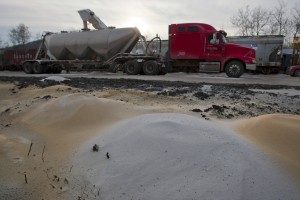How Could OSHA’s New Silica Rules Impact The Natural Gas Industry?
-
Katie Colaneri

REUTERS/Adam Fenster /Landov
A truck is filled with sand at Wellsboro & Corning Railroad in Wellsboro, Pennsylvania.
Federal labor officials are proposing new rules to help prevent an old hazard of the trade: diseases caused by breathing in silica dust. Silicosis has long been a plight of workers in construction and manufacturing, but concerns have shifted in recent years to those who toil in the growing natural gas industry.
Sand is an important ingredient in most fracking fluid recipes. It’s mixed with chemicals and water and blasted deep underground where the tiny grains help keep cracks in the shale rock open for all that natural gas to come through.
But before it goes underground, federal health administrators say it can end up in worker’s lungs. Breathing in sand or “crystalline silica” can cause silicosis, a respiratory disease that can also lead to lung cancer, tuberculosis, kidney and autoimmune disease.
Last year, the National Institute for Occupational Safety and Health (NIOSH) found that workers in the fracking industry had some of the highest levels of exposure to silica. NIOSH collected air samples from 11 sites in five states, including Pennsylvania, that showed silica exposures more than ten times the permissible level.
The new rules released by the Occupational Safety and Health Administration last week would cut the permissible exposure limit in half and require better education and training for workers on the hazards of silica. Companies would also be required to offer medical exams for workers and to monitor exposures.
Taking ‘a very personal toll’
Labor unions like the AFL-CIO pushed OSHA to update its regulations which have not been touched since 1971.
“It… levels the playing field for the employers who do want to do the right thing, who are already trying to improve workplace health and safety,” said Jim Frederick, a health and safety expert with the United Steel Workers of America in Pittsburgh. “It ensures their competitors who may not have the same desires to provide a safe workplace have to provide a safe workplace.”
Frederick said silicosis and related diseases take “a very personal toll” on American workers exposed to the dust, many of whom begin experiencing shortness of breath and difficulty walking short distances despite being otherwise healthy. He believes one problem may be that doctors are discouraged from diagnosing patients with silicosis out of fear of being caught up in workers’ compensation lawsuits.
OSHA estimates the rules would save 700 lives and prevent 1,600 new cases of silicosis each year. The number of silicosis-related deaths has decreased sharply over the last four decades to around 200 cases a year, according to the Centers for Disease Control.
The Pennsylvania Department of Health currently reports 29 people died of silicosis between 2007 and 2011. 2008 saw the highest number of fatalities from silicosis at 10 deaths.
More regulation vs. better enforcement
Many industry leaders say the decline in silica deaths shows current federal standards are working, and that stricter regulations aren’t necessary and could even hurt businesses.
Marc Freedman, executive director of labor law policy at the U.S. Chamber of Commerce, spoke to the Associated Press about his concerns about the ability of current equipment to accurately measure the lower exposure limits.
“I don’t want this to become all about employers not wanting to spend money on safety, but there will clearly be a cost impact here and there’s a question about whether they can even comply,” Freedman told the AP, adding that he would expect the hydraulic fracturing industry to take one of the biggest hits.
OSHA expects implementation of the new rules would cost around $550 for small businesses with less than 20 employees and about $1,242 for larger companies.
Joe Hurt is a Vice President at the International Association of Drilling Contractors. The problem, he says, is that federal compliance assistance specialists have been unable to participate in meetings with the industry due to sequestration and federal budget constraints.
“You can’t measure the value of one life, but continued emphasis on helping companies comply with current regulations to me is more important than setting a lower [permissible exposure] level,” Hurt said.
Federal regulators have not left the oil and gas industry out of the conversation. For the past year, OSHA has been meeting with trade groups to discuss ways to lower the hazards for workers.
Kenny Jordan is the executive director of the Association of Energy Service Companies, one of the groups that has been working with the federal government. Jordan said the industry groups didn’t take part in any talks about what the new rules should look like, but they are making progress toward better educating workers about the risks of silica and creating better ventilation systems to keep the dust down.
Jordan doesn’t yet know how the rules could impact the industry, but he said trade groups like his plan to take advantage of the public comment period to make sure the regulations are “workable for everybody.”
“OSHA has done some things in the past that we’ve not been real happy with and not given us input, but we’re at least glad this time they’ve allowed us to help and engage industry,” Jordan said.
















